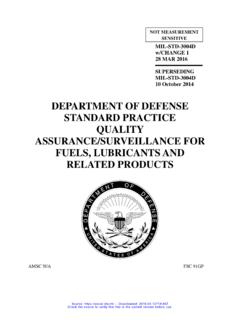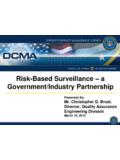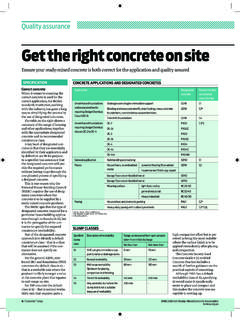Transcription of Keeping records - Health and Safety Executive
1 101 Keeping This part of the code provides guidance on the different types of records and explains exactlywhat you need to record and why. The table at the end of this part gives a summary of therecords and the reasons for Storage recordsYou do not have to, but you might find it helpful to keep records of all the contents of yourchemical store (for both fixed and mobile stores). These records will: help with stock rotation and control; keep an accurate and up-to-date list of the contents of the chemical store if there is anemergency; help you avoid overstocking; help you to make sure that you do not have any unapproved or unwanted pesticideproducts; and help you to use up oldest stocks first to avoid is best practice for you to keep a copy of the current stock list away from the store itself butwhere it is still easy to get to. Section records of pesticide treatmentsBylaw, those who produce food and animal feed must keep records of pesticide are two EC regulations which demand this: EC Regulation 852/2004 on the hygiene of foodstuffs (Annex I, part A, III ( record Keeping ));and EC Regulation 183/2005 on the hygiene of feed for livestock (Annex I, part A, II (Recordkeeping)).
2 Both came into force on 1 January 2006. They explain that people who produce or harvest plantproducts for people or animals to eat must keep records of any plant protection products(pesticides) or biocides they use. Other people, such as vets, agronomists and farm technicians,can help you to keep these professional users will need to keep records of applications in the future. You should keepthese records now as part of good has always been very good practice to keep records of all activities involving storing and usingpesticides, not just those products applied as a spray. These records are useful to refer to ifpeople, crops in the next field, other creatures or the environment are accidentally contaminated,or if someone claims that contamination has taken place. Accurate records will also help you meet the terms of any pesticide conditions, such as: the time that needs to pass before harvesting; intervals between repeat applications; periods when livestock cannot go on a treated area; and periods when workers cannot enter treated areas.
3 PSD will publish more guidance on the format you should keep records in and how long youshould keep them for. Make sure you can fill them in easily and without mistakes, and that theyare understandable and can be read quickly. Annex F gives a suggested format for a satisfactory treatment record for the time being. Theserecords can be written by hand in a book or entered on a computer. It is better if you do not useloose pages in a binder because pages can be you are a member of a crop assurance scheme or the woodland assurance standard, you willneed to meet specific conditions for making and Keeping treatment records . You also need tokeep certain records for is good practice to record treatments made to areas close to homes or other properties which alot of people occupy (such as schools, residential homes, hospitals and so on). You may want torecord the date and time, name the pesticide used (including the MAPP number), refer to anyenvironmental or COSHH assessment made, refer to any notice given to the area or signs set up(including when they were put up and taken down) and so on.
4 You may also want to keep arecord of any questions you receive from your neighbours. Section 6103If someone suggests that they may have been affected by a pesticide, it is important to givethem, their advisers or the HSE full and accurate information as soon as possible (including thefull name of the product with its MAPP number, any other information such as risk and safetyphrases and medical information). This information will normally be shown on the product is best if you make sure you keep your records to hand in your farm or local office. Informationis then easy to get to and not just kept by suppliers, contractors or advisers. When you use acontractor, they should make and keep records on applying the pesticide and, as the owner oroccupier of the treated land or local treatment manager for the local authority or other treatedarea, you should ask the contractor for a copy of these records . It is also a good practice to assess and record the effectiveness of each pesticide treatment after asuitable time has passed.
5 This information is important in identifying problems with: how the pesticide has been applied; crop damage (possibly only affecting certain varieties); or any resistance pests are building up. These records can help you to: improve application methods and product choice; share information with pesticide and equipment manufacturers; and supply information to PSD as appropriate. COSHH assessment recordsA record of a COSHH assessment, when one is needed, should include: the full name of the pesticide (and the relevant HSE or MAPP number); the possible risks to Health which may result from pesticide being used; the steps which you need to take to prevent, or adequately control, exposure in line withCOSHH; and the other action necessary to meet the obligations of COSHH for example: using and maintaining measures which control exposure; monitoring exposure; Health surveillance ; and training and instructing those who use can find information on pesticide resistance and the work of the various resistance actiongroups on the PSD website ( ).
6 Keeping records104 You must keep COSHH assessment records readily records of environmental risk assessmentsA record of any environmental risk assessment should include: the name of, and a description of, the pesticide (as for a COSHH assessment record ); the possible risks to wildlife and the environment which may result from using thepesticide; the steps you need to take to prevent, or adequately control, exposure of wildlife andthe environment; the specific details needed when you apply a pesticide in line with the LERAP schemes,and any other information which may be relevant when you use pesticides in certainsituations (for example, when using a pesticide in or near water); and details of any nearby springs, wells or boreholes or groundwater source protection zoneswithin the treated area, and the action you need to take to prevent contamination records of monitoring exposureIn situations where your employer needs to monitor exposure to pesticides, the monitoringrecords should provide adequate information on: when your employer carried out the monitoring and what the results were; what monitoring procedures were used and how long the monitoring periods were.
7 And the type of samples which were taken, where the samples were taken from, the work inprogress at the time and, in the case of samples taken from people, the names of thepeople being Maintenance records of exposure control measuresUnder the COSHH regulations, employers and self-employed people must keep suitable recordsof inspections and tests of engineering controls and respiratory protective equipment (RPE).A suitable record of each inspection and test of RPE will include: the name and address of the employer responsible for the RPE; details of the equipment including any distinguishing number or mark, together with adescription that is adequate to identify it, and the name of the maker; the date of the inspection or test and the name and signature (or unique authentication)of the person who carried it out; the condition of the equipment and details of any faults found including, in the case ofcanister or filter respirators, the condition of the canister and filter; details of any repairs carried out as a result of the inspection or test; in the case of compressed-air or oxygen apparatus, the pressure of the air or oxygen in thesupply cylinder.
8 And in the case of airline-fed apparatus (except half-mask respirators used occasionally againstdusts or fumes of relatively low toxicity), the flow volume and quality of the supplied air. Ifthe air supply is from a mobile compressor, you should carry out this test immediatelybefore using it for the first time in any new the case of airline-fed half-mask respirators used occasionally against dusts or fumes ofrelatively low toxicity, employers and self-employed people will just need to record : the responsible employer s name and address; the date of the inspection or test and the name and signature (or unique authentication)of the person who carried it out; and the condition of the equipment and details of any faults must make sure it is clear which item of RPE the record relates Health surveillance recordsIn situations where your employer needs a formal procedure to assess the Health of pesticideusers, the records should include the following details for every employee using pesticides.
9 Their full name, sex, date of birth, permanent address and postcode, National Insurancenumber, the date their current employment started and a record of any previous jobswhere they were exposed to substances Health surveillance is needed for. The results of all other Health surveillance procedures, the dates when they were carriedout, and details of who was responsible for each surveillance programme. You shouldinterpret these results in terms of an employee s fitness for their work and include, whereappropriate, a record of the medical adviser s or doctor s decisions, or the conclusions ofthe medical practitioner, occupational Health nurse or other suitably qualified orresponsible person. You should not include confidential clinical information. If Health surveillance involves only Keeping an individual Health record , you should recordthe details listed in the first bullet point above. As well as these detailed records , you should also keep an index or list of the names ofpeople who are undergoing, or have undergone, Health should make sure they keep records for the appropriate length of time (see thefollowing table) and that they can be referred to easily.
10 This is particularly important if there aresignificant changes in the business (such as a change of ownership or change of businessactivities). In the case of Health surveillance records , if a business stops trading, the employershould offer these records to the Disposal recordsIf you are moving or disposing of waste, you must keep a copy of each waste transfer note (anda written description of the waste) for at least two years. For hazardous waste, you must keep acopy of each consignment note for at least three 6107 Table 7:Summary of records to be keptType of recordTime kept forReason for recordsPesticide storerecordsUntil updated To give an accurate list of the contents of your chemical store in anemergency. To help you with stock be decided To show that you have used pesticides appropriately, safely and law, food and feed producers must keep these records . At present itis good practice for all other professional users to keep records , but thiswill be law in the future.














